Going South (by K. Frankum)
I opened one eye, the other eyelid was a bit sticky with dried blood. I had to rub it first, but something had brushed against my leg… a weka, with another weka behind it. The second one must have been a male, he had that downbeat, nagged look.
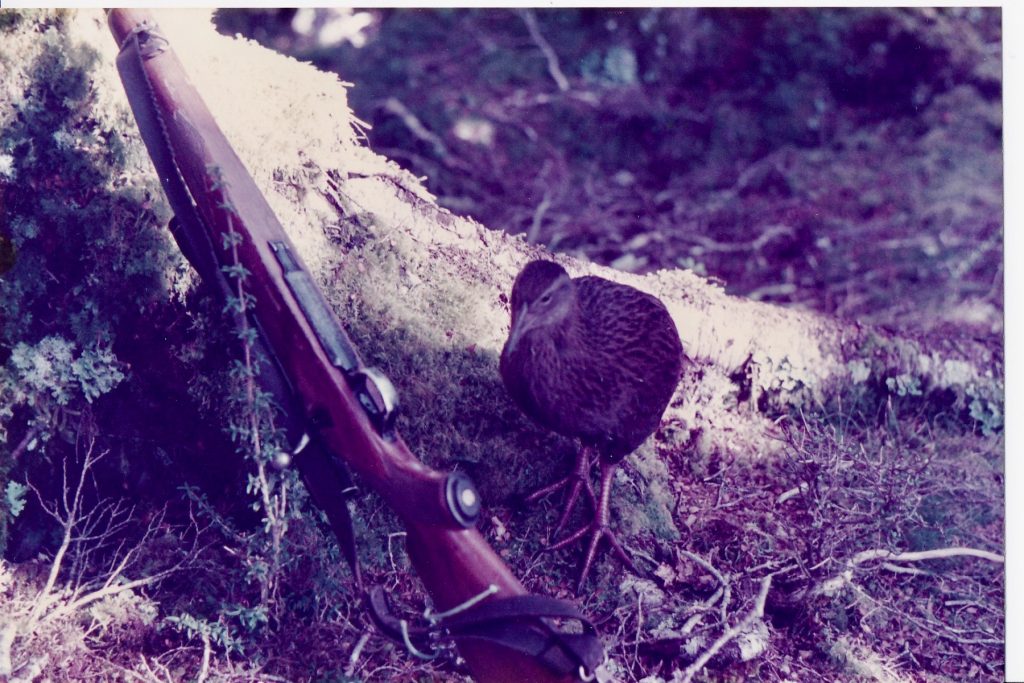
It was daylight and it wasn’t raining.That was good. My bottom lip felt like Huw Richards after Buck Shelford dealt to him in ‘87. My tinfoil survival blanket was in shreds, and that wasn’t good. But the 12 point wap/cross head lying on the ground made everything all good.
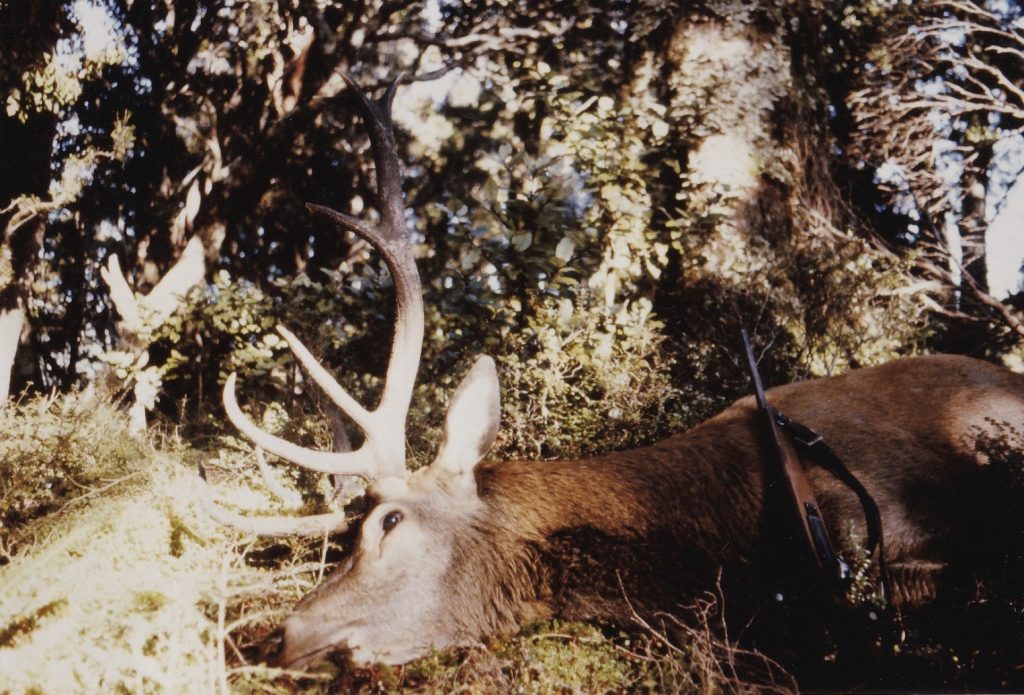
Now what was it with these damn wekas? The penny dropped – the half hollow log I was sleeping in was their home, no wonder they were pissed off! I politely asked them to go away, and wriggled out of my log. But I’m getting ahead of myself…
Well, it all started when we got a letter telling us we had the Mount Tanilba Wapiti Block. Forty years ago emails weren’t a thing, social media was non-existent and Silicon Valley was the gap between Dolly Parton’s tits, (oops, enough of that, sorry BRB).
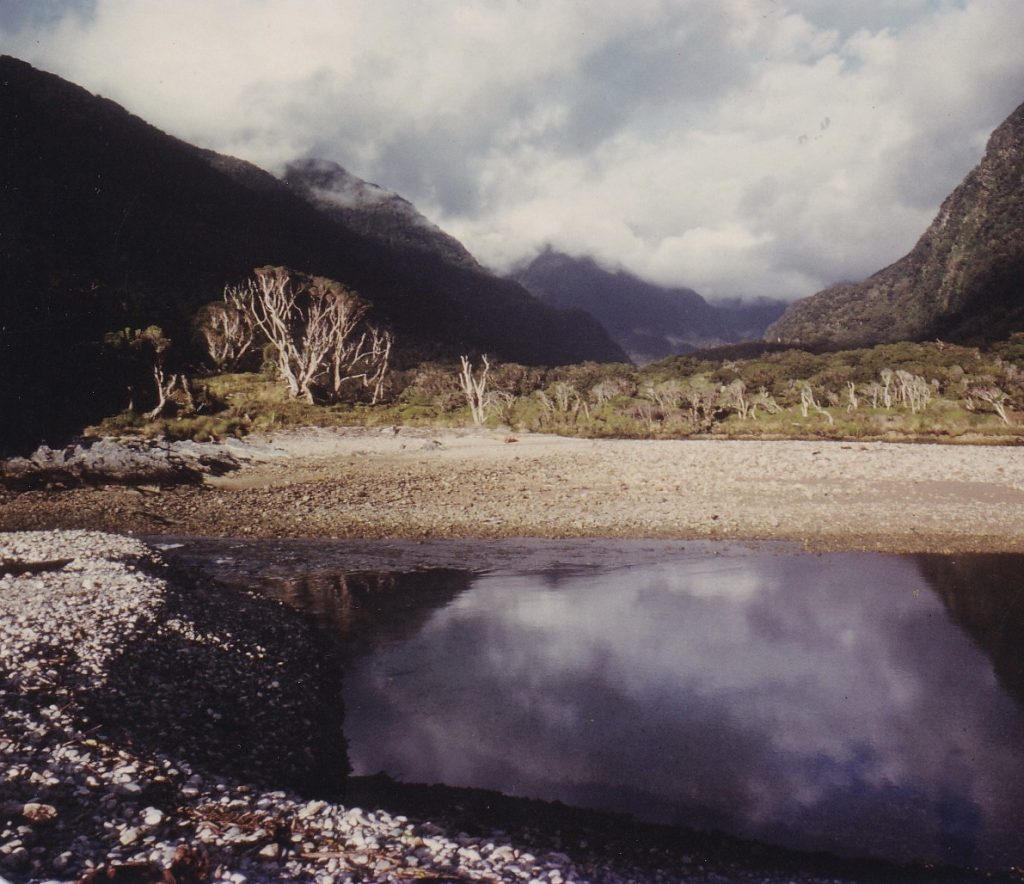
So my good mate, Brian and I were driving south (road trips are always better than flying). We had caught an early ferry and were about 30 kilometres before Murchison, going past the Gowanbridge turn off to Lake Rotoroa. It was one of those drab autumn days, on the coast, cold and about to rain. It had just stopped raining, but I was thinking it would start again soon. We were past in a flash but there was a glimpse of a hitchhiker, who looked like a tramper. I thought, should we, should we, hmmm maybe? Bugger it, poor basket, he looked a bit bedraggled, so we turned around…
Well, he was a young German guy, about our age, all sorts of flash kit, Lederhosen poly props, Bavarian marching boots, flash pack, a walking pole… bugger me. And I thought my Japara sleeping bag cover was the go.
We got chatting. He was going to Greymouth, that was good, we were going to Hokitika.
He had been over the Travers Saddle, down to Lake Rotoroa, and had got a lift to the Gowanbridge junction on the back of a cocky’s ute. He’d been waiting for a lift for two hours.
Brian said, “Hear any roaring, you know, stags?”
Well, he had heard all right. All night he had heard these angry beasts, “Gott in Himmel, ” he muttered, “snorting and coughing and roaring.” I told him he was lucky it was night time, asking had he not seen the warnings from the Tourism Board? He hadn’t – “oh dear,” said Brian.
We explained that the deer around Murchison had evolved into omnivores, due to the lack of magnesium. Gunther got the gist… they had been known to prey on solo trampers. At night he was safe, as they spent all night mating and roaring, then they slept till lunchtime. After that they got hungry, and wandered around in mobs, looking for a feed. That caused another, “Gott in Himmel,” with a couple of “Achtungs” thrown in. It was like those war comics I used to read when I was six.
It started to rain. One of us suggested, probably Brian, that if we gave him a lift to Greymouth, how about he shouts a couple of pies and beers at the Murchison Pub for lunch? Well before you could say, “we sunk the Bismark”, he was in the wagon and we were off. We did explain we had pulled his leg, but I’m not sure he trusted us after that. We dropped Gunther off, on the best of terms, in Greymouth, after buying him a couple of beers in Reefton, international relations preserved.
Next stop was Hokitika.
The day was drawing on, so we paid for a basic cabin at the motor camp, scoffed a burger each, then picked up a box of beers and headed out a few kilometres to see Ray Tinsley. At that time he was probably one of the most active wapiti hunters of his generation, and had just published a book, “Call of the Wapiti.” (Highly recommended, along with its sister book, “Call of the Moose.” I had phoned him the week before, and we had an invite. For two green, young hunters, it was like visiting royalty.
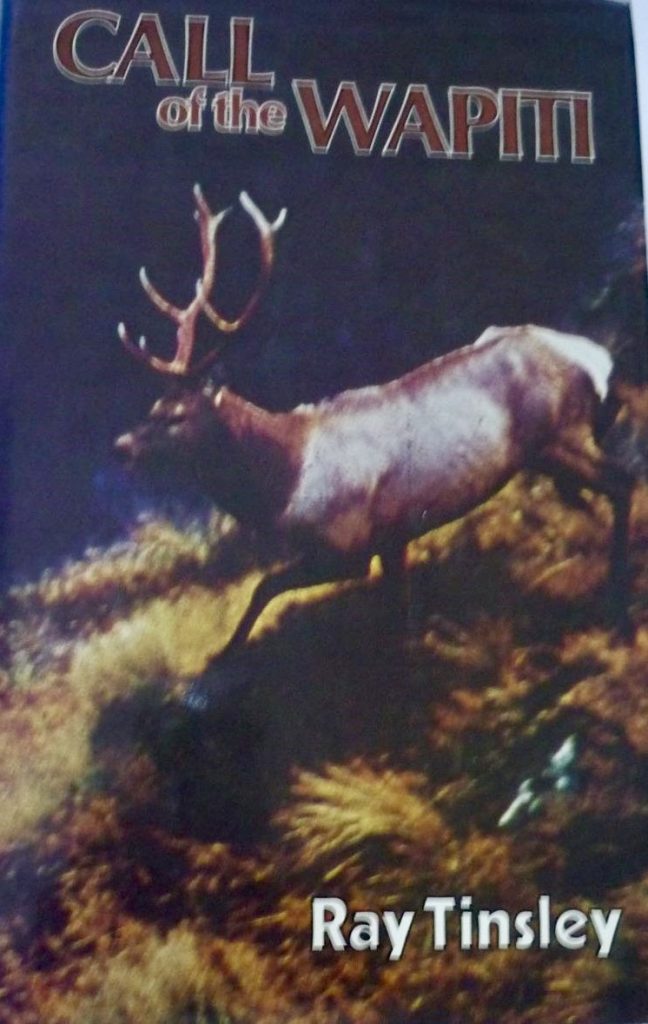
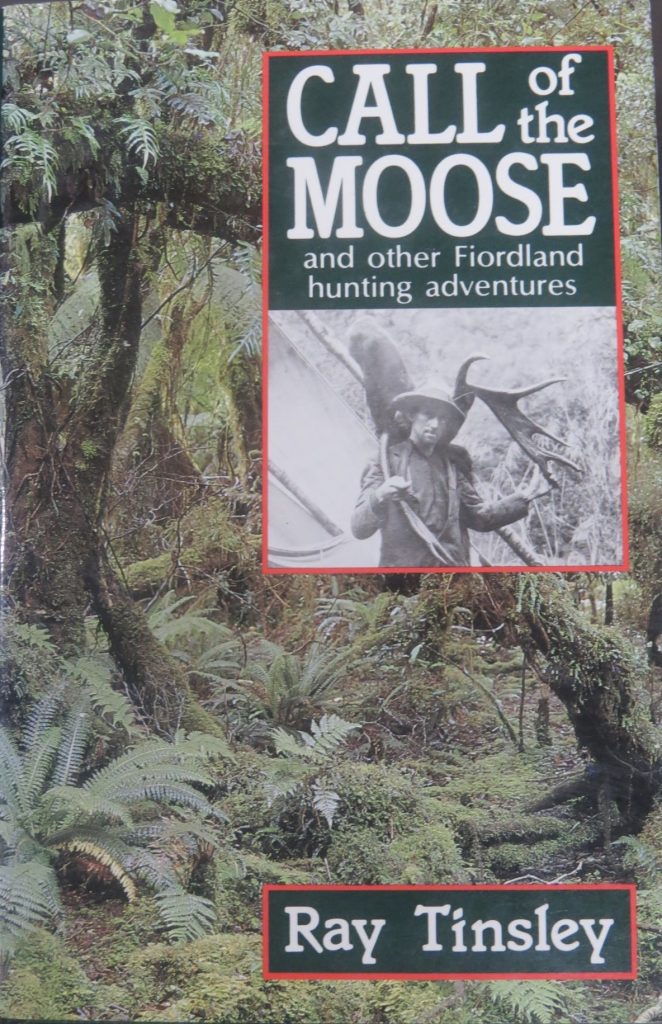
Ray was great, so laid back, gave us lots of advice, and showed us his trophies. The bit of advice I will never forget was, “Back yourself. If you see that trophy bull across the valley, or over the hill in the next watershed, go for it! As long as you have survival gear, and the weather doesn’t turn, you can survive for at least two or three days. “You may never get another crack at him.” Top man, Ray Tinsley.
The next night found us in Te Anau. After a long day on the road, the first job was to catch up with our ride. Terry had a cray boat. Myself, along with three other Hawkes Bay hunters, had met him the year before. Another top South Islander.
The plan was we would meet him at Milford, at 7 am the next day. The weather forecast was primo, our gear was packed, and my Japara sleeping bag cover had a fresh spray of waterproofing. What more could a young hunter want?
By 10 am, we were heading out of Milford Sound, turning left and heading down the Coast.
Terry and his mate got a big frying pan going, we all feasted on bacon and eggs, baked beans, and toast. The sea conditions were great, just a big lazy swell. Poison Bay, Sutherland Sound, Bligh Sound, George Sound, Looking Glass… they all slipped past. We dropped and lifted a few pots around the mouth of George Sound. Huge rock faces, hanging valleys, with the ranges turning blue in the distance in the late afternoon sun.
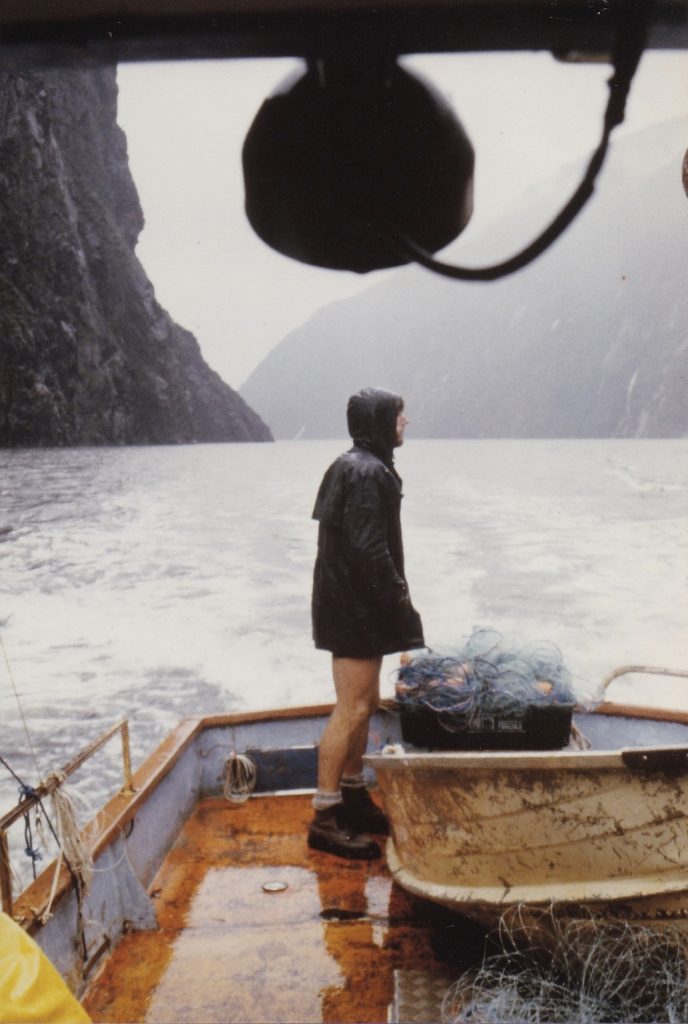
Two Thumb Bay is an exposed little cove. It faces due west, but today we had no issues with landing, sitting on our packs whilst Burt rowed us to the beach. Terry had given us a dirty, white towel. “Tie this to a stick.” They were working their pots between Charles and George Sound this week, they would be cruising past every day, going one way or the other. “If you get into strife, do what the Italian Navy does every time it sees a ship it doesn’t recognize – wave the White Flag!”
“We will call in, and pick you up at low tide, 2 pm, in 8 days.” This was reassuring, as we didn’t have a radio, and emergency locator beacons hadn’t been invented.
Five minutes later, the Okarito disappeared around the headland and it was quiet. Our camp was forty metres behind the beach. I stayed there last year. An old shirt was still tied to a tree, half a kero tin was sitting by the rock fireplace we had made, and a wee brook bubbled or babbled thirty metres away, so it was like coming home.
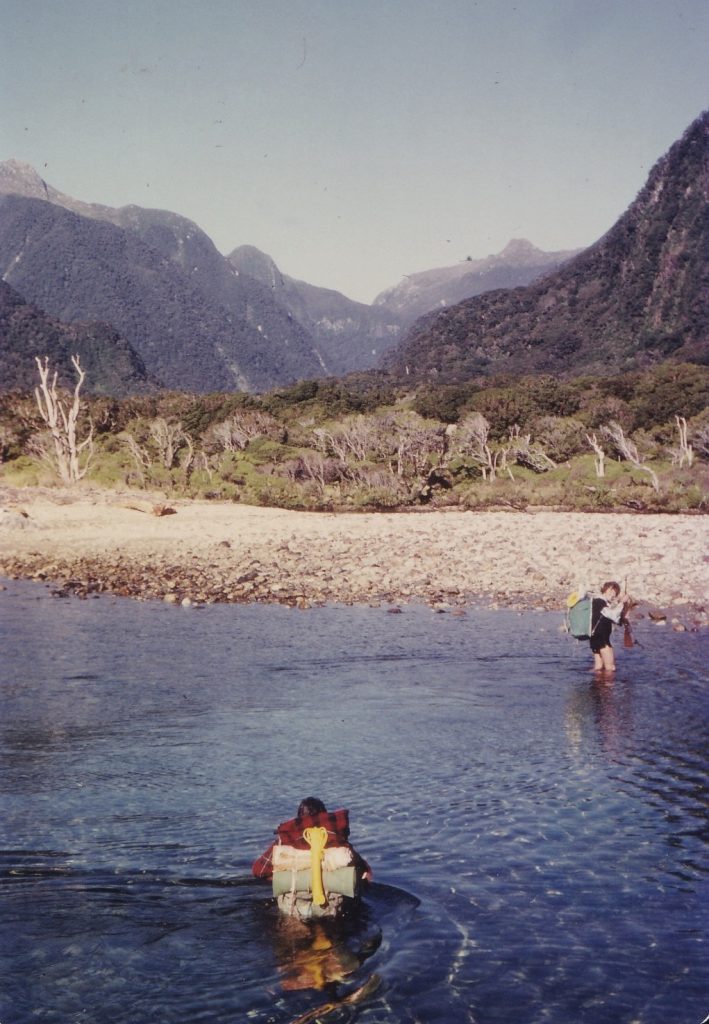
We only had an hour before dark, so just pitched the tent. Always have a tent with insect mesh if you are camping near the coast in Fiordland. There are sandflies in the day, and big fat mosquitoes at night. The wind was blowing up the valley, so it would have been stupid to light the fire, so made a hot soup on the kero primus and went for an early night. However, I was still a bit hypo, and about 11 pm was struggling to sleep, so I got up quietly and walked over the dunes to sit on a log by the high tide mark. Way up in the hills were a couple of red stags, roaring each other into a frenzy, no moon, more stars than you could count, even if you lived for 500 years. Orion, my favourite constellation, was up there, 700 light-years away. Every 20 seconds a big wave would crash, and if it wasn’t for the odd roar, I could have been sitting here 20,000 years ago…
Next day we spent all morning sorting the camp, re-pitched the tent, put a fly over it, then a bigger fly, so we had a couple of metres in front. We dug a trench around the tent with my army fold-up spade. Got in a supply of dry wood for cooking, and for boiling any heads in the kero tin. Fiordland can be a harsh mistress. Rule number one, get a good camp sorted. That afternoon, Brian went for a wander upriver. I went north around the coast, but got bluffed out after an hour. I found another old campsite, maybe undisturbed for 20 years, with just a few rusty billys in a cave, and some poles tied together to make a bunk, above the rocks.
The next day we were away at daybreak, climbing up onto the main ridge to the north of the Two Thumb River. It was another bluebird day, actually too warm. We heard no stags for the first hour. It was a steady 700m climb to the top ridge from the coast and below us was the sea, and Two Thumb Bay. If you have a look on NZ topo, you can see where our camp was, at the south end of the bay, up against the hill that climbs up to Mount Tanilba. There is a tidal lagoon where the river enters the sea. You need to cross this to head up the valley, otherwise it is a bit of a mission going round the side in the mud and swamp. At very low tide it’s about knee height, at high tide it is neck height, so the trick is to carry your pack on your head. But not at night, as from our camp we could hear splashes and gurgles. One day I found half a fish, a kahawai or a big mullet, that something had chomped. Probably a seal. Brian told me he saw a dorsal fin on the evening of the second day, but I didn’t believe him, although I did notice after that he always asked me to cross first.
Anyway, we got to the top, leaving a few markers on the way up. It wasn’t that bad, climbing up, but it’s always harder finding the route going down. On the top of the ridge was the biggest wallow I have ever seen, maybe 50m across There were a couple of stags, hanging around, but just scrubbers. Not much roaring, just the stags I had heard from the beach the night before, way across the valley.
We were travelling light, just a pikau, water bottle, survival gear, some rope, and rations for the day. We headed north along the ridge towards Looking Glass Bay. Good open bush and plenty of sign, and after about 20 minutes, we heard a hybrid roar, back off a side spur, beyond the wallow, half roar, half bugle. I thought at the time, worth a look maybe…
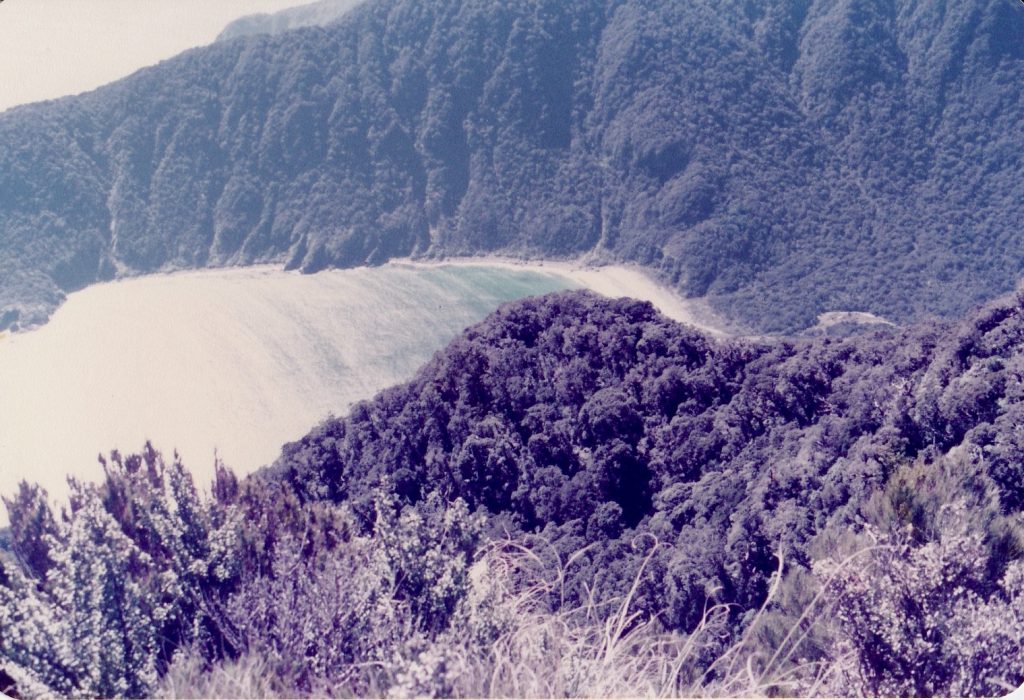
Well, we had a great day, walking and looking. At one stage we were directly above Looking Glass, while way down the coast we could see a cray boat lifting pots, near the mouth of George Sound.
We had a good look at the tops above the Whitewater, but no sign or deer trails. This was at the height of the helicopter shooting, so most of the deer had learnt to live in the bush. Anyway, we got back to the wallow, about ninety minutes before dark, feeling a bit flat, having seen nothing but the scrubbers earlier on, with only the odd, sporadic roar. We were about to pick our way down, when the hybrid stag I had heard eight hours ago, let out a roar bugle, and was answered by one of the motley red stags below us.
Brian looked at me, gave me a grin, and said, “yours!” I think I said, “toss you for it,” but he insisted. What a great mate. He gave me what tucker he had left, cheese and crackers I think, wished me luck, and high tailed it for camp, while he still had enough light to drop 700 metres and get back just on dark.So the stag was, I guessed, about 800m away, somewhere along this narrow gutted spur. The breeze was good, I checked my Ruger M77 270 – all good. Now that I was by myself, I slipped one up the spout, with a half open bolt, and gingerly started sneaking along. It was all bush, with the odd open slip, the ridge was maybe five metres wide, and dropped off very steeply to my right, 700m down to the Two Thumb River. He was roaring every few minutes, occasionally getting a reply, so I kept quiet. After a bit, I came to this log across the ridge, couldn’t go under, but I just managed to get a leg over, and slide across. Fool me, I should have remembered that log later. A bit further, and I saw a patch of brown grey, it was a big wapiti hind, such a big deep chest. Beautiful, she watched me for a few seconds, then mooched away below me. Where was that stag? Another hundred metres, no roars, had I spooked him? Surely I’ve passed him? Then, a grunt below me, 30 feet away… I could see an ear, an antler, looked ok, a neck… boom! Thank goodness a clean kill – if he had gone five metres, there was a huge bluff…

Well, it took me five minutes to get my heart rate back down. Twelve points, tops a bit weak, more red than wap, but the best I had shot. It took a bit of wrangling to drag him just a few metres to a flattish bit. I took the full head skin, (my mate, Max Motley, a taxidermist, had drummed into me always take as much head skin as you can). I stuffed a back steak into my pikau, and put the head on my back. I wrapped the head skin which was still attached to the head, around it and tied it all up with a bit of twine.
There was still a bit of sun above the horizon, but I knew if I got as far as the wallow, I would be happy with that. All went well till I got to that log. I got halfway over it, with the head on my back, when, whoomph! I ploughed face first into the mud on the other side, in a big jumble of antlers. One of the tines ended up in my mouth, and ripped out a lump of my inside lip. I bled like a pig. Fool me, I could have lost an eye.
Twenty minutes later, I was at the wallow, with the sun well over Australia by now, with just half of it above the horizon. Away below, and to my west, I could see Two Thumb Bay, and the Tasman. First I needed water.
That’s the thing about Fiordland, although it has such a high rainfall, there are very few creeks high up. I had drunk all my water earlier and was quite dehydrated. No choice but the wallow. I had a light plastic cup, so I picked a puddle that looked like it hadn’t been pissed in lately by a roaring stag, used the cup to fill my drink bottle, then used one of my socks to filter water back into the cup… it tasted great, sort of.
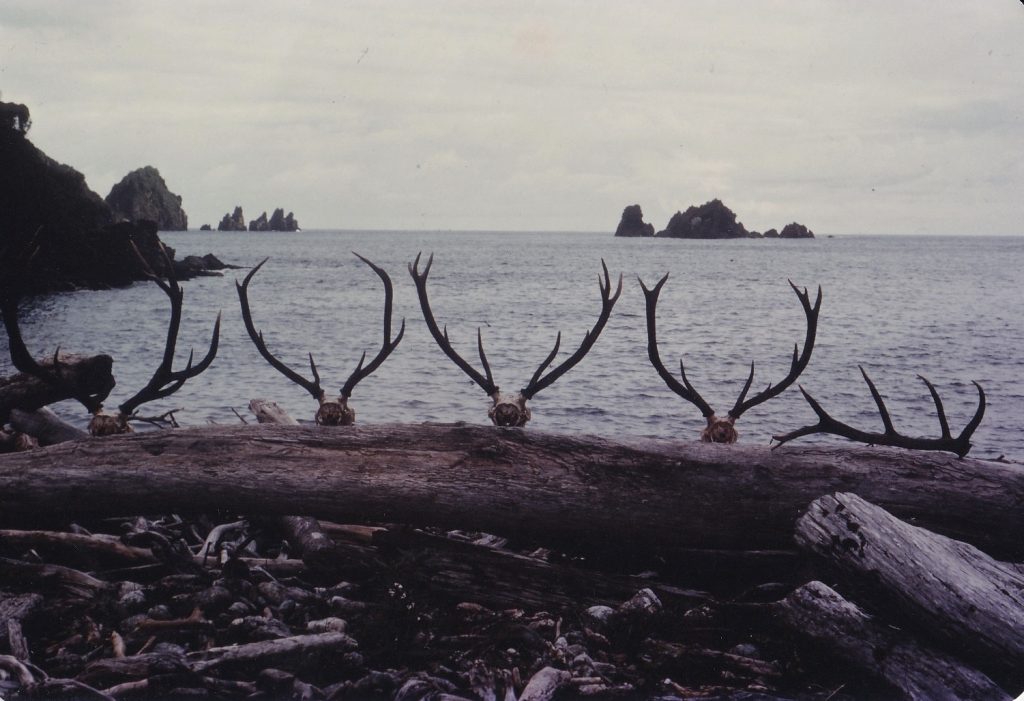
Next thing was shelter, as I was cooling down fast. I got my survival tin foil bag out, scoffed the last of the cheese, and yes, there was a log, and half hollow – a Three Star Log! Bliss. I put everything on, including a parka and wriggled in. I was still hot and sweaty, so I went to sleep quickly. About midnight, I woke, all my sweat had turned into condensation in the bag, and it was cold. I wriggled out of it and had another drink. It was a hell of a lot colder out, so I climbed back into the tin foil and into the log. I didn’t wake up until I was hassled by those wekas…
It was all pretty vanilla from then on. It took me three hours to get back to camp that morning. I needed to use the rope a few times to lower the head in front of me, but following the markers we had left, it gave me a route.
Brian had left a note, to say he had gone upstream and would be back that night. I spent all afternoon with a scalpel taking the skin off the head, being very careful with eyes and tear ducts. Then I boiled the head in the kero tin.
The day after was wet, so that was a pit day. Brian got a stag the next day, a ten pointer that I think was mostly red, but the weather was still too warm, so no roaring.
Day four, fortunately, we were at camp when Terry turned up about lunchtime. He yelled to us that he’d be back in a couple of hours, as there was a storm on the way. So after a quick pack up, we had a dodgy dinghy ride to the cray boat, and a trip to George Sound. The storm was still 36 hours away, and they had more pots to lift and store for the winter in George Sound. There were hundreds there above the high tide mark. Pots belonging to half a dozen Cray Boats.
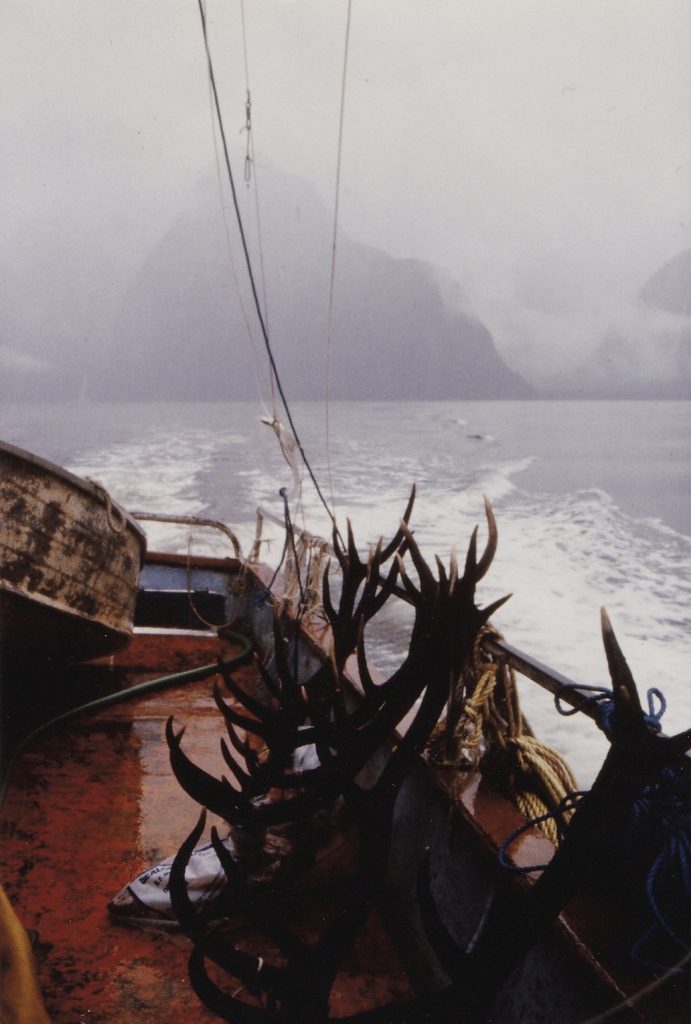
So when we got to the head of George Sound, we had an option, either the George Sound Hut, or he could drop us in the White Water. The party that had that block, had pulled out a week ago – Aussies, according to Terry. They only stayed four days, and then radioed in to get a heli out…
Well the Whitewater was a classic block, so how could we say no to that? Classic or not, all we saw in the twenty hours we were there, were footprints with a few bugles in the distance that night. But as we had a pick up at 10am the next day, we barely scratched the surface of it.
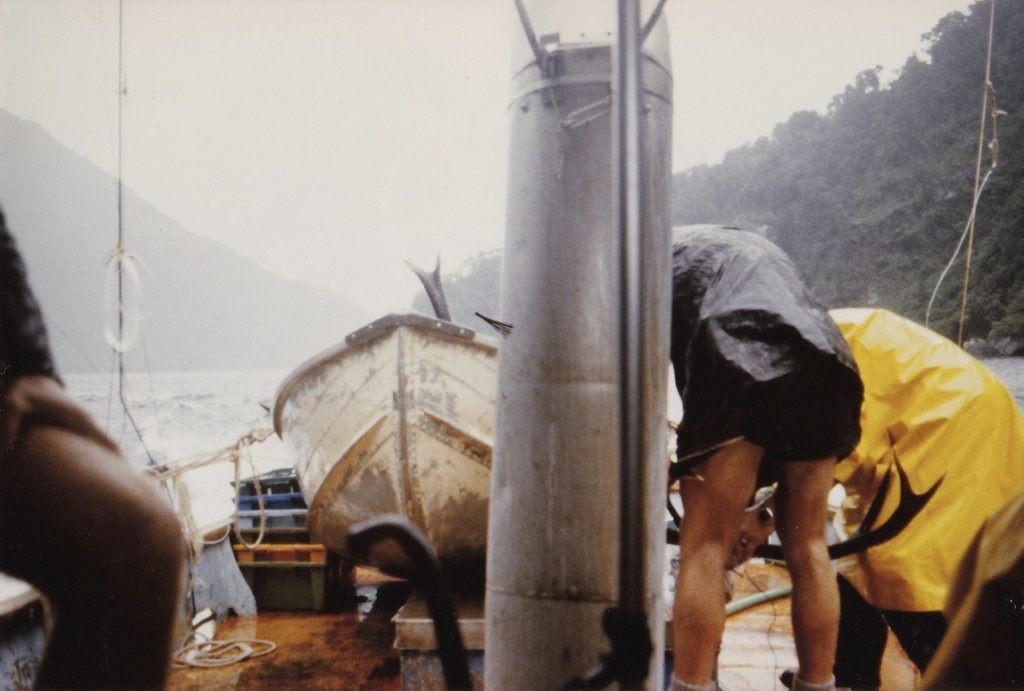
Back on the boat, we had driving rain heading out of George Sound and a rough swell all the way back to Milford. Once we were into the calm, Terry cooked up half a dozen crays and found some beers in the chiller, so a top way to finish a great trip.
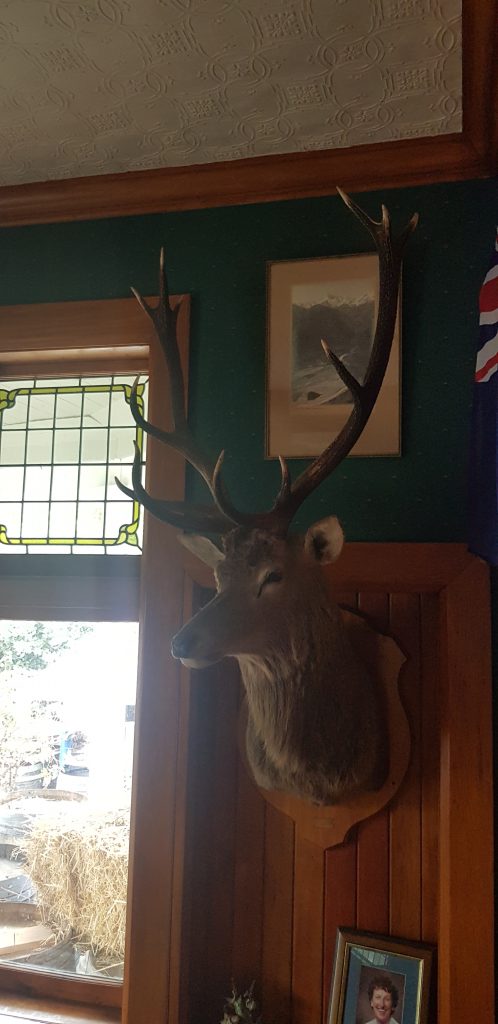
I ended up getting Max to mount the trophy, and whilst it’s not a great head, it has great memories.
Cheers. K Frankum



Great little read thanks 👍
Those are the memories to live with. And the reason we all want to return.